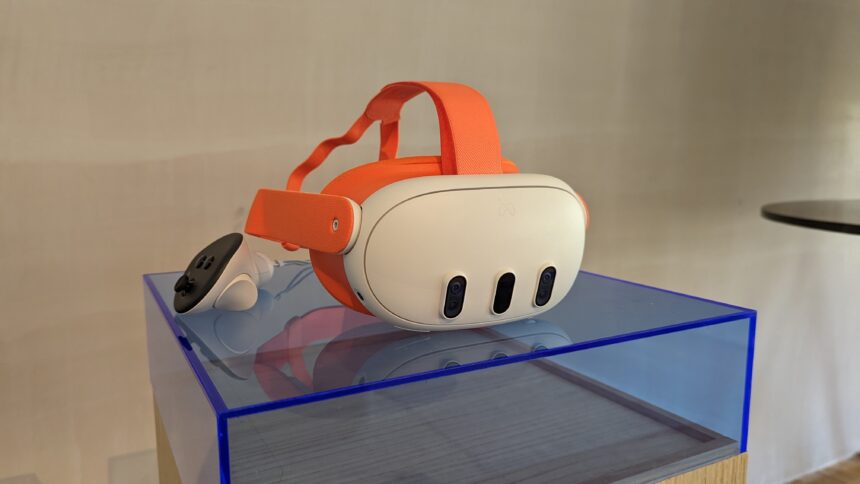Even though the Meta Quest 4 is not expected to debut until 2026, excitement is brewing around Meta’s confirmed releases of smart glasses this year. The tech giant plans to unveil three separate models, raising questions about their other extended reality (XR) offerings. Presently, information regarding the Quest 4 is limited. However, recent VR leaks suggest a possible shift towards a device likely called the Meta Quest Pro 2, which is rumored to carry the codename “Puffin.” This new headset is expected to boast cutting-edge specifications and a notably lightweight design, echoing the form factor of regular glasses, weighing in at an impressive 110 grams. Such a move would represent a bold step in Meta’s trajectory for mainstream products.
Nonetheless, the prospect of the Meta Quest 4 brings forth a realm of possibilities that could enhance user experience. Drawing from Meta’s statements and insider knowledge about their ongoing developments, several potential features come to mind.
First on the agenda is a transition to OLED technology. Although I’m not overly optimistic about this upgrade, it could be a significant leap forward. The pricing of the Quest 3 has already established a high bar, and the increased costs associated with OLED compared to traditional LCD could pose challenges for implementation. The primary advantage of OLED displays lies in their ability to produce true blacks in darker scenes, thereby enhancing realism and detail. This improvement would markedly elevate the immersive nature of VR, making experiences feel significantly more authentic than the limited backlighting of LCD screens.
While there are indications that the Quest Pro 2 may incorporate OLED panels, Meta has articulated ambitions to eventually roll out such advancements to its more budget-conscious models, contingent upon cost efficiencies. As such, mainstream adoption of OLED in the Quest lineup may take time—perhaps not until the Quest 5—unless affordable OLED options become viable in the market.
Another possibility could be the introduction of two Quest 4 variants: a standard model and an OLED version, similar to Valve’s dual offering with the Steam Deck. However, this could complicate matters by fragmenting an already limited VR user base.
The conversation surrounding entertainment in VR has gained traction, particularly following Apple’s Vision Pro initiative, which has reignited interest in the viewing capabilities of VR headsets. Not to be overlooked, filmmaker James Cameron’s recent comments about using his Meta Quest headset to stream Avatar add weight to this narrative.
Despite having some streaming options available, Meta’s headsets have yet to establish themselves as the primary choice for engaging with media. Accessing 3D content can be a daunting task, which is disappointing given the incredible visual experiences VR can deliver. My own adventure watching Avengers: Endgame in 3D through VR was nothing short of transformative, turning the viewing experience into something far more dynamic than traditional television. If the Meta Quest 4 includes an OLED option, it should leverage this entertainment potential by prioritizing content and application development.
Imagine a more user-friendly system where individuals could purchase or rent digital films from a dedicated marketplace, rather than being limited to subscription models alone. A specialized streaming service for movies—especially 3D options—with the ability to download for offline viewing would be a significant enhancement. Improving user access to content and refining existing offerings are vital for positioning Meta’s VR headsets as serious contenders in the entertainment arena.
Another practical enhancement I envision would be the integration of a built-in capture card into the Quest 4. Presently, users often rely on third-party capture devices, which is far from ideal. Having utilized an Elgato capture card to experience PS5 games on an expansive virtual screen, I can attest to how phenomenal that can be—ideal for those seeking a cinematic feel without the limitations of physical space.
If the Quest 4 could manage HDMI input, it would dramatically change how users connect with content, bridging the gap between Meta’s ecosystem and other devices, such as smartphones and laptops. Providing an HDMI-to-USB-C cable could further enhance user convenience, reducing the need for Meta to focus on producing additional streaming applications by allowing users to access the vast array of content already on their devices.
Shifting gears from entertainment, let’s consider the possibilities for environmental interaction capabilities. Upgraded passthrough technology stands out as another critical enhancement that could elevate the Meta Quest 4 experience. While current capabilities are commendable, significant improvements in color accuracy, graininess reduction, and distortion minimization would make mixed reality experiences much more engaging. These enhancements could greatly enrich users’ immersion, integrating the real world more seamlessly into the VR environment while also ensuring mixed reality applications are less taxing on battery life.
Lastly, an often-overlooked yet important upgrade would be to switch the facial interface material to silicone. The fabric coverings currently in use, while comfortable, tend to absorb sweat, leading to discomfort during prolonged use. Though cleaning them is possible, the effort often feels disproportionate to the benefit. By transitioning to silicone, the durability and hygienic standards would improve significantly, offering users a much more pleasant experience—especially beneficial for those who share headsets.























